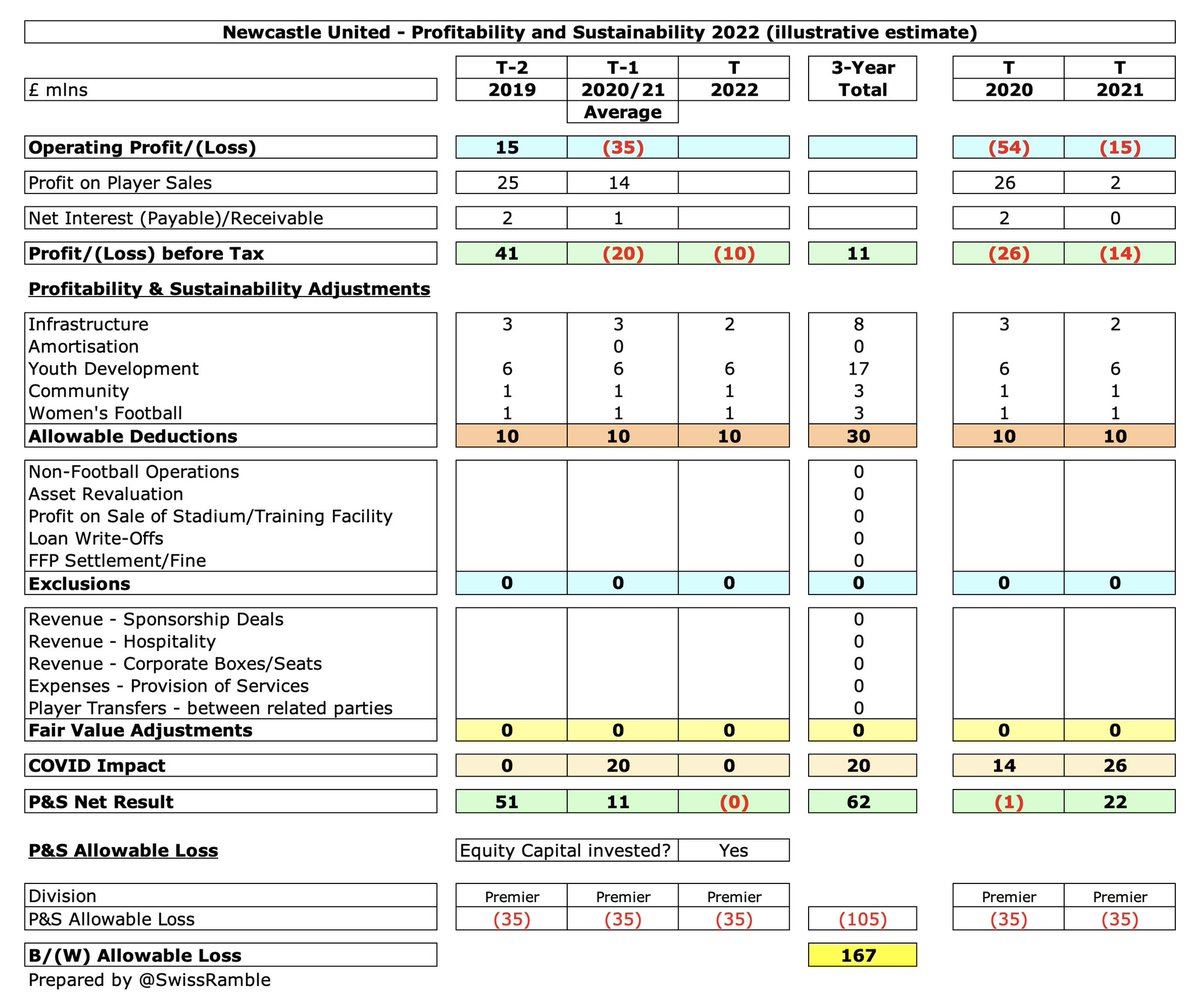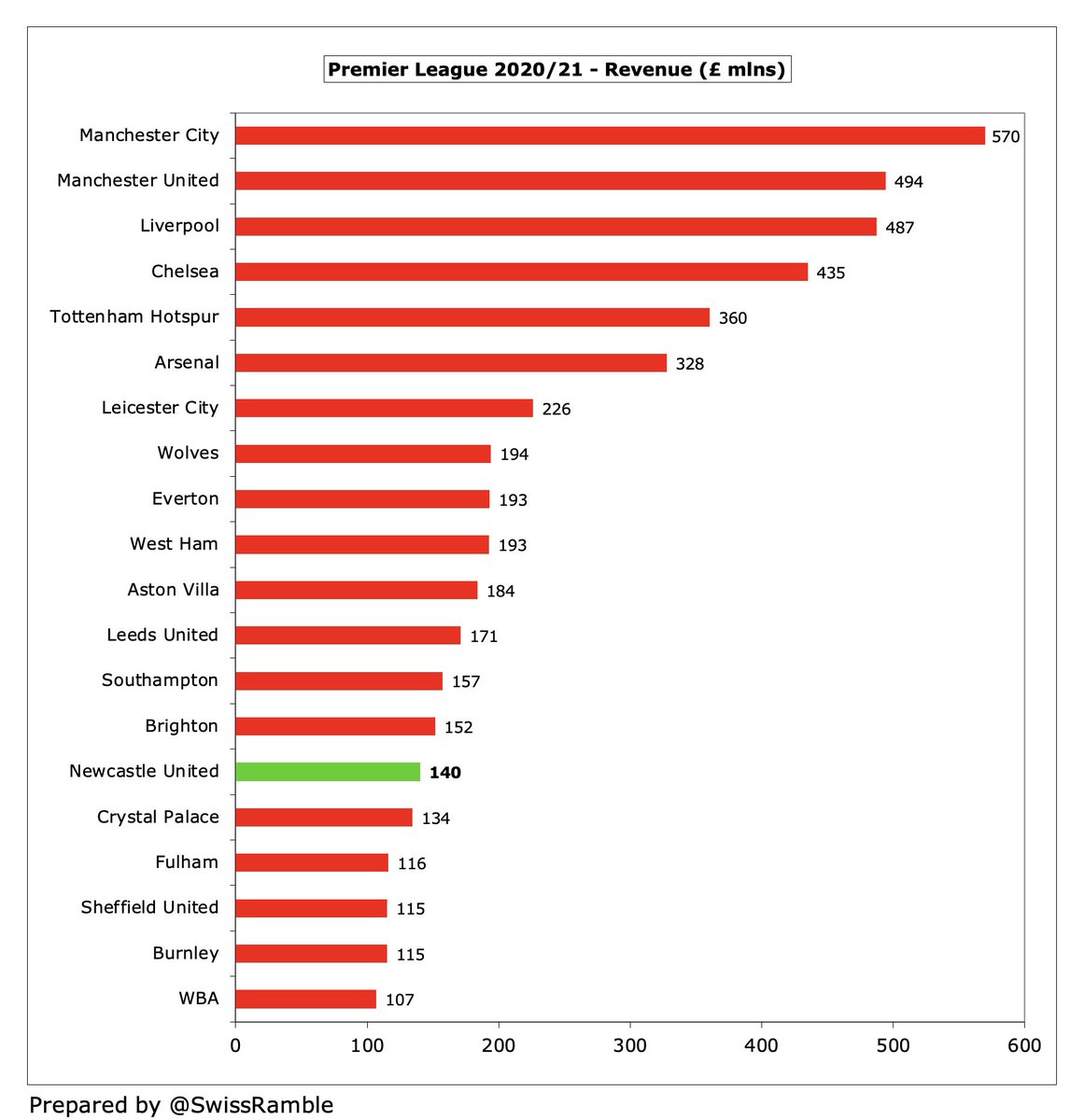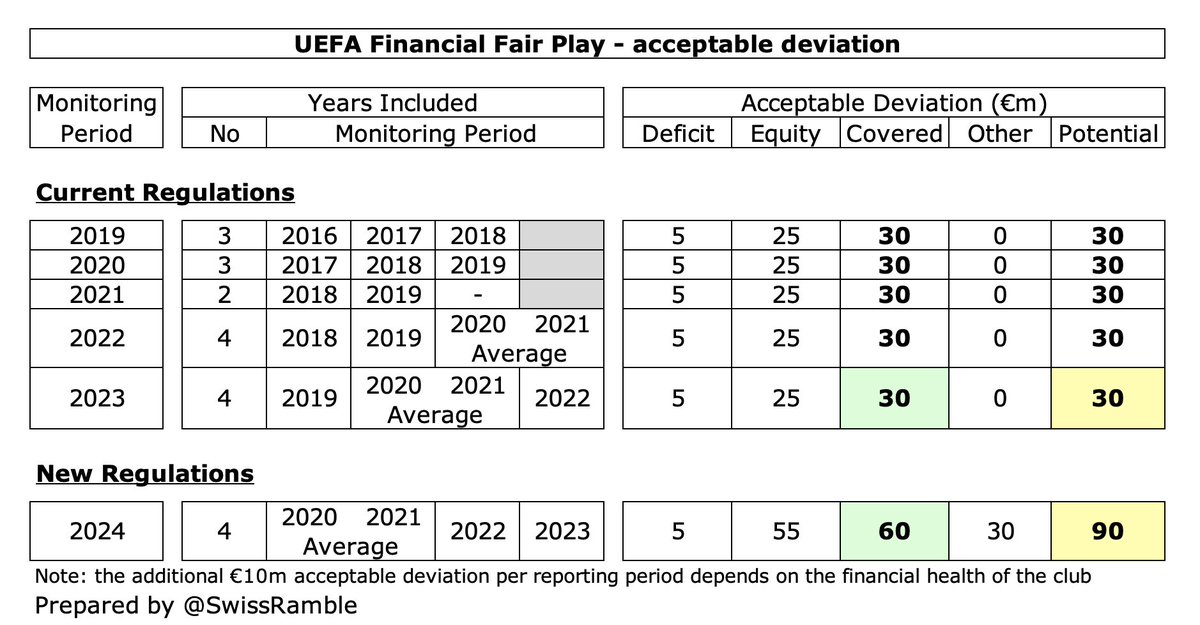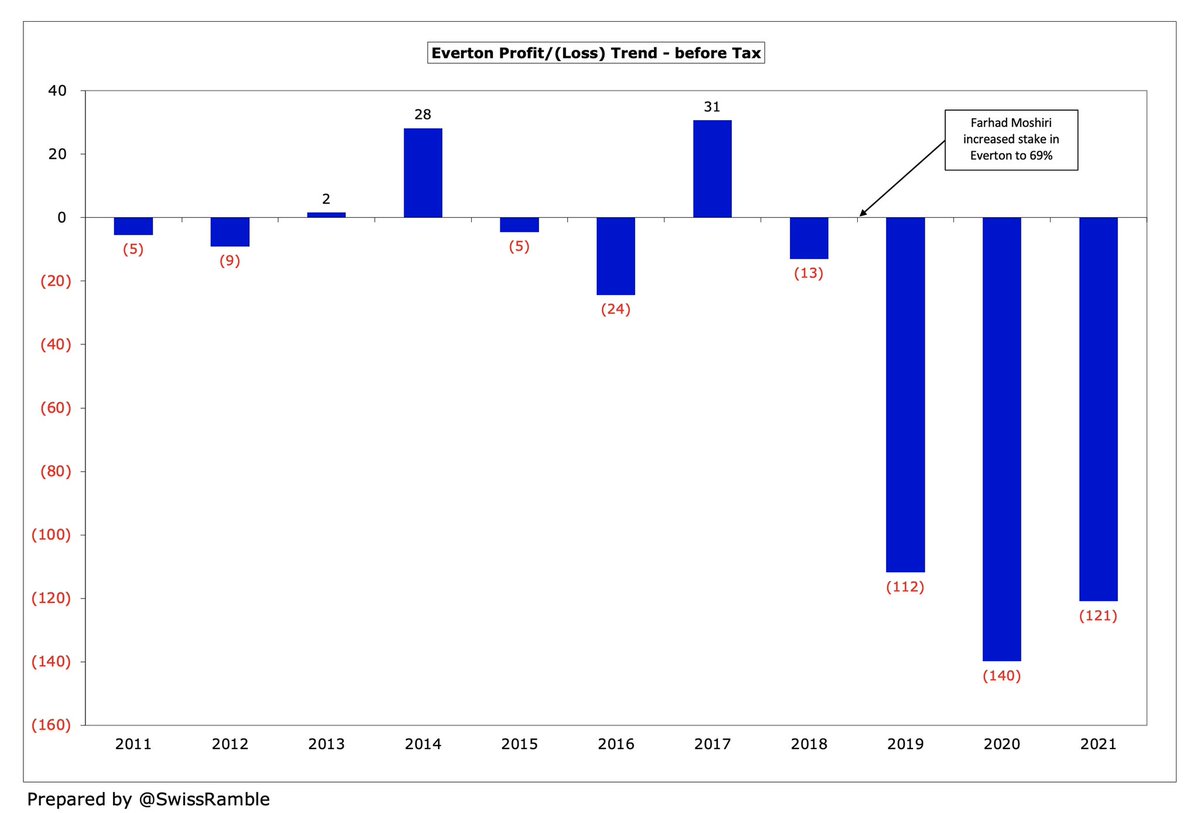When Newcastle United were bought by a consortium led by Saudi Arabia’s Public Investment Fund, the expectation was that #NUFC would splash out on players, due to the enormous wealth of the new owners, but that hasn’t really been the case. So why is the club not spending big?
#NUFC manager Eddie Howe gave this answer: “Financial Fair Play impacts us and will continue to impact us for a number of years. We haven't got the free rein that maybe has been perceived within the media, that we can go and sign who we want and pay extortionate fees and wages.”
Despite the fact that #NUFC new owners had stated that their ambition was to win the Premier League in “five to ten years”, Howe sounded a note of caution, “We’re having to be creative and smart and try and make the right additions within the financial constraints that we have.”
#NUFC spending ability is limited by the Premier League Profitability and Sustainability (P&S) rules. These allow a £5m loss a year, which can be boosted by £30m equity injection, giving allowable losses of £35m a year. This works out to £105m over the 3-year monitoring period. 

#NUFC were actually well placed in terms of P&S, thanks to Mike Ashley’s parsimonious approach, as they posted a £2m profit in the 3 years up to 2020/21 (despite the adverse impact of COVID), which was the fourth best financial performance in the Premier League over this period. 



Furthermore, the Premier League has relaxed the regulations to neutralise the adverse impact of COVID, so the 2022 monitoring period assessed the seasons 2019/20 and 2020/21 as a single (average) period. 

On this basis, #NUFC pre-tax profit over the adjusted 3-year monitoring period up to 2020/21 (the last published accounts) was a very healthy £44m, which was £149m better than the P&S maximum allowable loss of £105m. 

In addition, #NUFC can make a £30m adjustment for “healthy” expenditure of £10m a year (depreciation, women’s football, youth development & community), giving a P&S profit of £74m. Adding this to the £105m allowable loss gives £179m possible spend. 

Finally, #NUFC can also adjust for the adverse COVID impact, which the club listed as £14m in 2019/20 and £26m in 2020/21, giving a total of £40m for revenue loss net of cost savings. This was then averaged as £20m over the last 2 years. 



Therefore, #NUFC £44m pre-tax profit over the 3-year monitoring period was improved by £30m allowable deductions and £20m COVID impact to give £95m adjusted P&S profit. Added to £105m permitted loss, that meant the total spending potential after 2020/21 was an impressive £200m. 

#NUFC ability to spend is partly due to their relatively low investment in the transfer market. Although they did spend a quarter of a billion in the last 5 years, this was firmly in the bottom half of the Premier League, even behind the likes of #AVFC, #WWFC, #FFC and #SaintsFC. 



Transfer fees are not fully expensed when a player is purchased, but are written-off evenly over the length of the contract via player amortisation. So if a player is purchased for £30m on a 5-year contract, the annual amortisation would be £6m, i.e. £30m divided by 5 years. 

This is important, as it means that #NUFC could have actually spent much more on transfers than the £200m P&S surplus, as only the impact on profits is considered for FFP. We will later come to whether that would be advisable.
As it stands, #NUFC £32m player amortisation in 2020/21 was one of the lowest in the Premier League. This was partly due to prior year impairment reducing player values and a shorter 11-month accounting period, but fundamentally reflects the club’s limited transfer expenditure. 



The right way to look at #NUFC spending potential is as a combination of player amortisation (to reflect transfers) plus wages. On this basis, Newcastle United *could* have spent £600m on transfers, giving £120m player amortisation, with an additional £80m wages per annum. 

The essential point here is that #NUFC *could* have spent £600m and remained within the P&S limit, but would it have been the right thing for the club to do? Once more for the cheap seats, it wouldn’t really have made sense to use up all of their potential spending at once.
It’s also worth noting the impact of wages on this calculation. For example, if #NUFC transfer outlay was £200m with £200k weekly wages (say, 4 players at £50k), the annual cost would be £50m, but this would rise to £66m with £500k weekly wages. 

If #NUFC want to compete at the highest level, they will need to spend more on wages. Their £107m in 2020/21 was 17th highest in the Premier League (14th based on a 12-month accounting period). Either way, this is at least £200m below the top four clubs, led by #MCFC £355m. 



That is another challenge for #NUFC, as they will probably have to break their wage structure. As #MCFC discovered after their injection of funds, they needed to pay a premium to attract players to their project before there was demonstrable success on the pitch.
It’s also important to note that #NUFC have spent money since the 2020/21 accounts. Their activity in 2021/22 led to an increase in annual costs of around £52m, including the highest transfer spend in Europe in January (Bruno Guimaraes, Chris Wood, Kieran Trippier and Dan Burn). 

Adding the £58m transfer spend to date this summer on Sven Botman, Matt Targett and Nick Pope means a further £23m impact on the P&L (2022/23 accounts). Therefore, #NUFC have already used up £74m of the theoretical £200m potential spend under P&S rules. 

As a reminder, that £200m P&S spending limit was based on the 3-year monitoring period up to 2020/21, but importantly this is a moving target. In particular, that assessment included £23m profit from 2017/18, which falls out of the calculation the following season. 

If we assume that #NUFC made a £10m loss in 2021/22 (COVID impact deducted, 12th month of expenses added, low profit from player sales), then the spending limit would be reduced by £33m from £200m to £167m. 

The situation is even worse looking at the P&S limit for 3 years to 2022/23. First, we lose the £41m profit from 2018/19. Then, the #NUFC 2022/23 loss would be £84m, considering £74m increase in costs based on recruitment since 2020/21 accounts, leaving only £41m potential spend. 

Of course, this is a very simplistic estimate, but it does illustrate the point that there’s relatively little left of the £200m potential spend, either because profitable years have dropped out of the P&S calculation or due to the #NUFC expenditure since the 2020/21 accounts.
This helps explain #NUFC tight budget, as well as the club wanting to keep its powder dry for future transfer windows. As Eddie Howe observed, “The more money you spend in one window, the more it impacts your ability to spend in windows beyond.”
In reality, it is more difficult for #NUFC to copy #MCFC, who lost £562m in the 5 years after ADUG’s arrival. Howe again: “We can’t just go out and spend money on players like maybe teams could have done in the past, and totally change their squad within one transfer window.” 

Where #NUFC will seek to emulate #MCFC is their incredible revenue growth. City’s income was lower than the Magpies before their wealthy owners arrived, but it has shot up from £82m to £570m. Newcastle’s Mehrdad Ghodoussi said, “What Sheikh Mansour has done there is fantastic.” 



In order to spend more on players #NUFC simply have to grow revenue. In 2020/21 their £140m was only 15th highest in the Premier League. Although the comparison is distorted by different amounts of revenue deferred from 2019/20, this was still less than a third of the top four. 



The obvious area to exploit is commercial, which Ashley failed to grow at all in his 14 years, so #NUFC have fallen way behind their rivals. Their £21m in 2020/21 was less than a tenth of #MCFC, #MUFC and #LFC, but more meaningfully also below clubs like #BHAFC, #AVFC and #WWFC. 



#NUFC shirt sponsorship with Fun88 is only £8m, though deal has been terminated 2 years early, so are free to sign a more lucrative deal from 2023. Have already agreed £7.5m Noon sleeve sponsorship, but will look for agreements for stadium naming rights, training kit/ground, etc. 

Again #NUFC will look to #MCFC for their example, as their commercial revenue has surged from £21m in 2008 (before their wealthy owners bought the club) to £272m, the highest in England. It would be no surprise if Newcastle attracts some new sponsors from Saudi Arabia. 

However, one challenge for #NUFC will be to comply with new Premier League rules to ensure sponsorships are deemed to be fair value. This is difficult to assess, as we have seen with the extensive review of #MCFC Etihad deal (ultimately considered “not too excessive” by UEFA).
One strategy to ensure FFP compliance is player trading, as seen with #CFC, who have offset large operating losses with £344m profit from player sales in the last 4 years. There is plenty of room for improvement here, considering #NUFC relatively small £56m profit in this period. 



#NUFC will look to qualify for Europe, where the financial rewards would have a significant impact on finances. In 2020/21 England’s Champion league representatives earned between £70m and £105m, while the Europa League was worth £14m to £26m. Only earned €5m in the Ashley era. 



If #NUFC do qualify for Europe, the UEFA FFP rules would be stricter than the Premier League with the allowable losses (“acceptable deviation”) over 3 years being only €30m (including €25m equity contribution), though this will increase to €90m from 2024. 

UEFA have also introduced squad cost control via a new ratio of player wages, transfers & agent fees that is limited to 70% of revenue & profit on player sales, though there will be a gradual implementation over 3 seasons (90% in 2023/24, 80% in 2024/25 and 70% from 2025/26). 

UEFA’s initial guidelines suggested that certain expenses previously excluded from the FFP calculation (youth football, infrastructure, community & women’s football) could no longer be deducted in the new rules, but they have since clarified that there is in fact no change here.
This is important, as it means no limit on what #NUFC could invest in stadium and training ground. This has been a key element of #MCFC strategy with their academy producing some top talent. Under Ashley, #NUFC only spent £7m on infrastructure in last 10 years, lowest in the PL. 

#NUFC will have looked at the mistakes made by #EFC, who have reported £372m of losses in the 3 years since Farhad Moshiri increased his stake to 69%, but narrowly avoided relegation last season, despite spending £647m on new players in just 5 years. 



Although Amanda Staveley has stated, “We have the same ambitions as #MCFC – in terms of trophies”, she has also spoken of a more conservative strategy, “We need to build a sustainable, viable club that can eventually survive on its own.”
Things have already changed at #NUFC, as they have spent more under the new owners, but a combination of FFP restrictions and the desire to act in a sensible manner (until new revenue streams arrive) means that anyone expecting blockbuster signings is likely to be disappointed.
The arrival of director of football Dan Ashworth & chief executive Darren Eales indicates the approach #NUFC will take. Howe concluded, “We’re not without ambition. We’re well aware that we have to change the squad and make improvements, but it’s going to be a difficult balance.”
• • •
Missing some Tweet in this thread? You can try to
force a refresh























